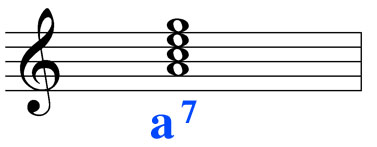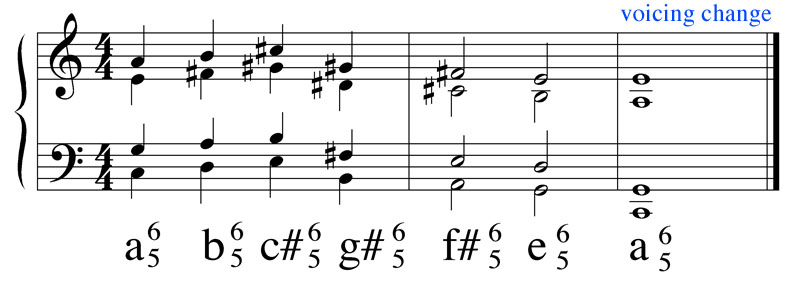2. Parallel Motion. After voicing this initial chord, we can transpose it and place each statement of the same sonority in succession. Although this may appear to produce what visually looks like a chord progression, in effect there is no creation of tension (being that all of the chords are of the same quality) and thus no need for release. What we lose in tension, we gain in terms of greater flexibility regarding phrase length and rhythmic disposition of each statement. Although typically each iteration of the chord will have the same voicing, some variance can be presented, as with our final chord in the example below.
Note that since each chord has exactly the same intervallic structure, the more we transpose it the further the series of chords fail to fall under one traditional key signature, which further distances this style of writing from the Common Practice.
Voice Leading in Nonfunctional Harmony. When approaching the question of voice leading in nonfunctional chords, we can apply many of the same principles from traditional harmonic practices. However, the use of the word 'progression' may be misleading in this case since the term implies hierarchical relationships between the sonorities. Overall, this style tends to be most effective when using more complex chords, rich in character, which can evoke a variety of keys.
1. When deciding what chords to choose in a succession of nonfunctional harmonies one can employ a common tone to segue from one sonority to another. In the example below, for instance, the melody in the first bar consists of an A rising to a C. Therefore, in our first harmony we have included a C in the chord (D7). We used this technique again in bars two and three (see blue outline).
2. Planing, while useful, can become tiresome if used too frequently. If used sparingly and carefully, it can be very effective within a larger context as the technique draws attention to one type of sonority.
3. Using enharmonic tones to tie two discreet harmonies together allows the composer to quickly shift from one key region to another. In the example below in bar four the Ab is re-interpreted as G# in the next harmony.
4. Non-harmonic tones are equally valid in this style as in the Common Practice, (see red circles below) and can bring temporal tension to the otherwise ambivalent chords.
5. Global key relationships can still be maintained, even within a style such as this that suppresses much of the scalar-based triadic harmonies associated with Common Practice, cadence-driven writing. In our example we begin with a D based sonority and cadence on an a minor triad: a tonic/dominant relationship, however veiled, remains.





